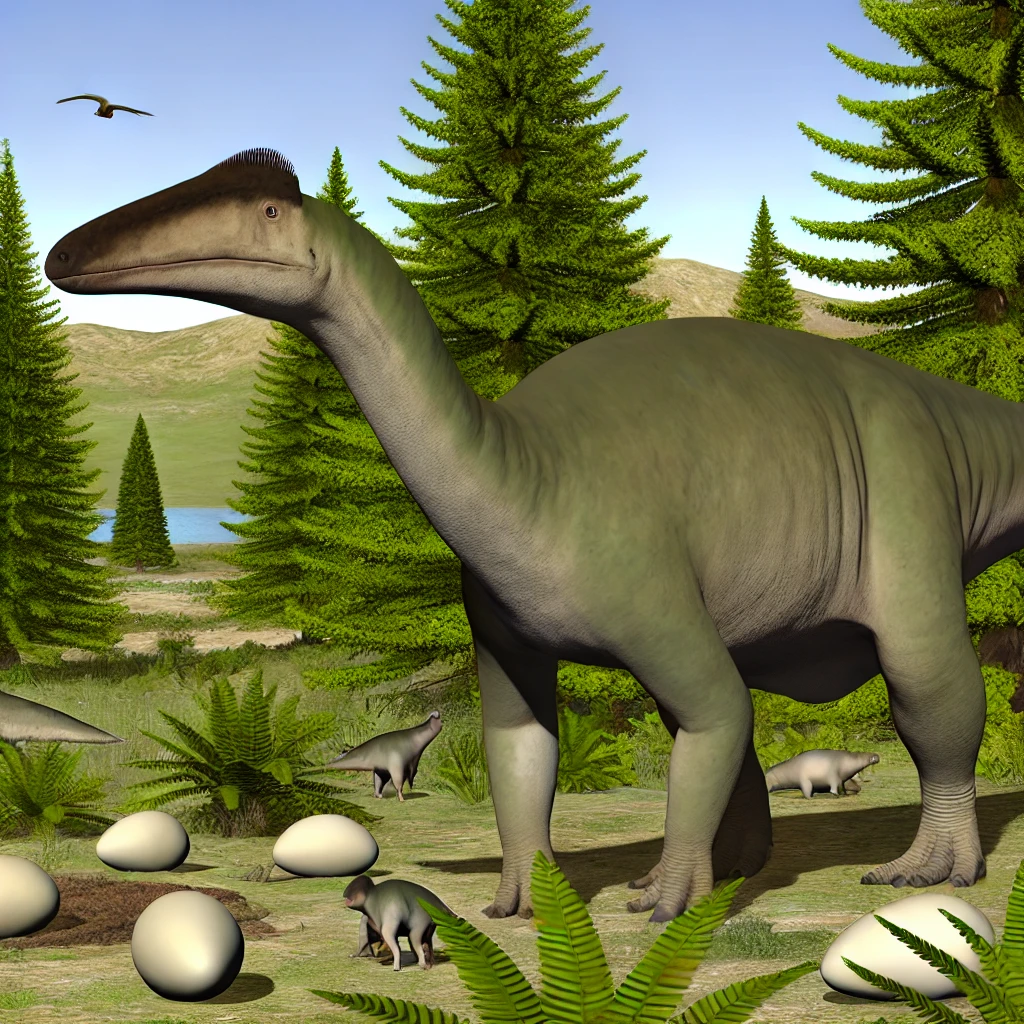Pronunciation:
My-ah-sore-ah
Name Meaning:
“Good mother lizard”
Dinosaur Classification:
- Kingdom: Animalia
- Phylum: Chordata
- Class: Reptilia
- Order: Ornithischia
- Suborder: Ornithopoda
- Family: Hadrosauridae
- Genus: Maiasaura
- Species: M. peeblesorum
Dinosaur Description:
Maiasaura is one of the most famous and well-studied hadrosaurid dinosaurs due to the wealth of fossil evidence surrounding its behavior, particularly regarding its care for young. This medium-sized herbivorous dinosaur lived in what is now North America during the Late Cretaceous period, about 76 million years ago. Its fossils have been primarily found in Montana, specifically in a nesting ground that provides remarkable insight into the parenting behavior of dinosaurs.
Maiasaura had a flat, broad snout and a distinctive crest above its eyes. This crest was likely used for species recognition or visual communication among individuals. Like other hadrosaurs, Maiasaura had a “duck-billed” appearance, with a toothless beak at the front of its jaw, ideal for clipping tough vegetation. Behind the beak, it had hundreds of tightly packed teeth that were used for grinding plant material. These teeth were continuously replaced as they wore down, which was an important adaptation for a herbivore that likely fed on fibrous plants.
What makes Maiasaura stand out is the discovery of fossilized nests, eggs, embryos, and juvenile skeletons, which suggest that these dinosaurs provided parental care for their young—a rare and significant finding in the study of dinosaur behavior. The nests, which were found closely packed together in colonies, contained eggs that were arranged in a circular or spiral pattern. After hatching, the young Maiasaura were thought to be fed by adults until they were large enough to leave the nest. This behavior of nurturing young has led paleontologists to describe Maiasaura as the “good mother lizard.”
Maiasaura lived in herds, providing protection from predators. Their ability to live and raise young in large groups likely contributed to their survival, as the nesting grounds show that Maiasaura returned to the same sites to lay eggs year after year.
Dinosaur Diet and Behavior:
Maiasaura was a herbivore, feeding on tough, fibrous plants. Its diet likely included conifers, ferns, and other low-lying vegetation. The structure of its jaws and teeth suggests that it was well-adapted to grinding down plant material. It lived in herds, and its social behavior extended to nesting in colonies, where adults likely worked together to protect their young. Fossil evidence suggests that Maiasaura parents fed their young and stayed with them until they could survive on their own.
Dinosaur Size:
Maiasaura grew to an average length of about 30 feet (9 meters).
Dinosaur Weight:
Maiasaura weighed around 2 to 3 tons (4,000 to 6,000 lbs).
Fossil Discoveries:
Maiasaura fossils were first discovered in the Two Medicine Formation in Montana by paleontologist Jack Horner and Robert Makela in 1978. The discovery site, known as “Egg Mountain,” contained extensive fossilized evidence of nesting grounds, including eggs, hatchlings, and juveniles. This provided unprecedented insight into the reproductive and social behavior of dinosaurs.
What Period Did The Dinosaur Live:
Maiasaura lived during the Late Cretaceous period, approximately 76 million years ago.
Notable Facts or Trivia:
– Maiasaura is the first dinosaur known to exhibit evidence of nurturing its young.
– The discovery of “Egg Mountain” revolutionized the understanding of dinosaur behavior, showing that some species cared for their young after hatching.
– Maiasaura had large nesting colonies, similar to some modern bird species.
– It was one of the first dinosaurs to be extensively studied in terms of parenting and social behavior.
Scientific Significance:
Maiasaura has become a symbol of dinosaurian parental care and social structure. Its discovery and the subsequent research have greatly influenced how paleontologists understand dinosaur reproduction and behavior, offering clear evidence that some dinosaurs exhibited complex social behaviors. The nesting grounds in Montana provided crucial evidence that dinosaurs were not solely solitary creatures but could live in large, cooperative groups.
Extinction & Legacy:
Like most dinosaurs, Maiasaura went extinct around 66 million years ago during the Cretaceous-Paleogene (K-Pg) extinction event. However, its legacy lives on through the wealth of knowledge gleaned from its fossils. Maiasaura remains an iconic species in paleontology, particularly for its role in revealing how some dinosaurs raised their young. The discovery of Maiasaura continues to inspire new generations of paleontologists and deepens our understanding of dinosaur behavior and evolution.
